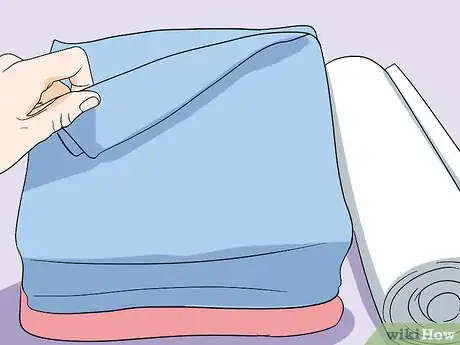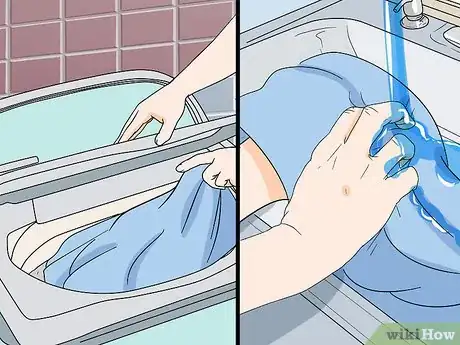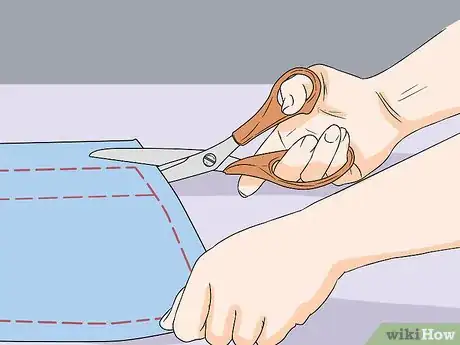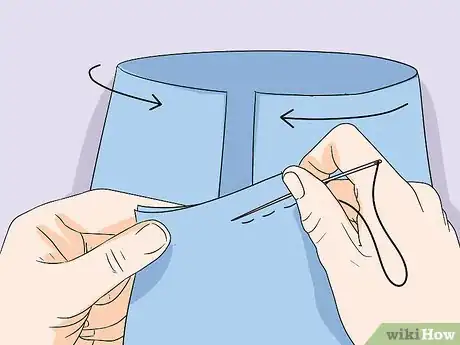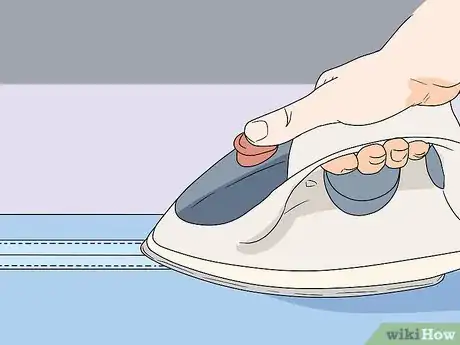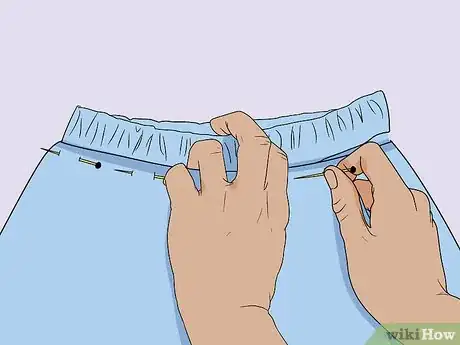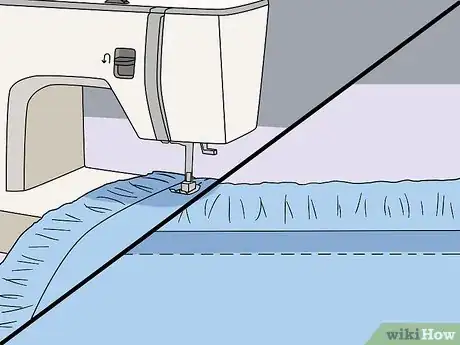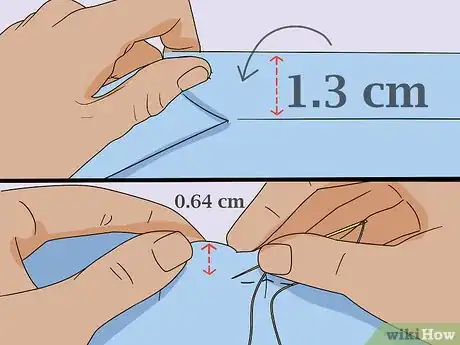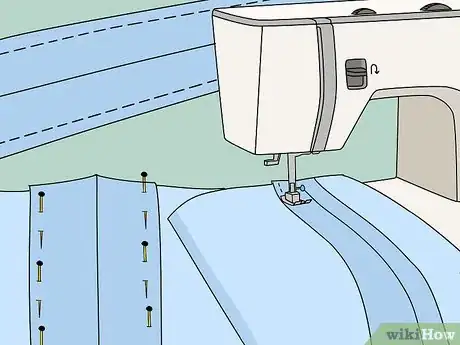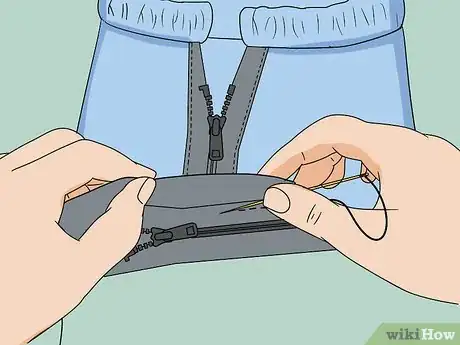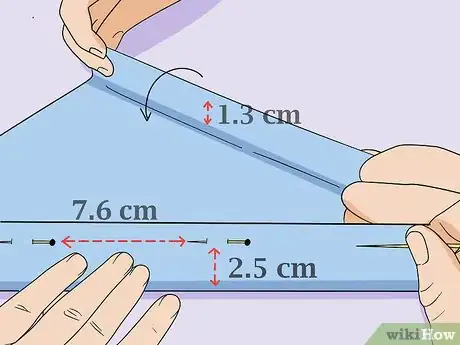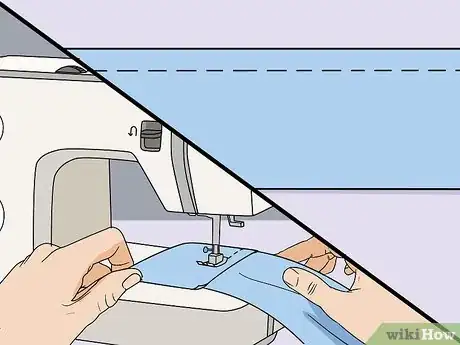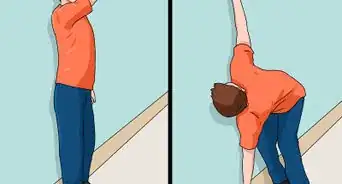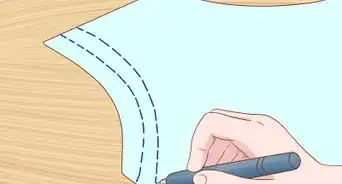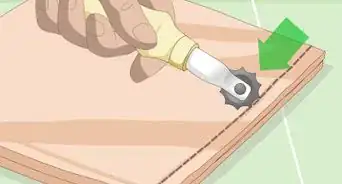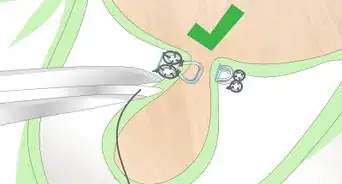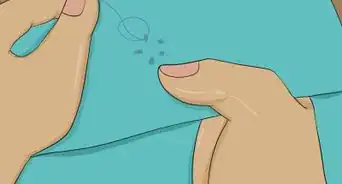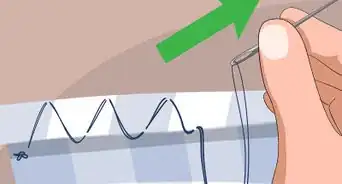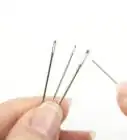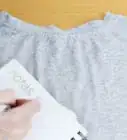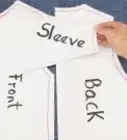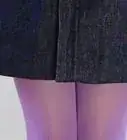This article was co-authored by wikiHow Staff. Our trained team of editors and researchers validate articles for accuracy and comprehensiveness. wikiHow's Content Management Team carefully monitors the work from our editorial staff to ensure that each article is backed by trusted research and meets our high quality standards.
There are 10 references cited in this article, which can be found at the bottom of the page.
This article has been viewed 61,917 times.
Learn more...
A skirt lining ensures that the fabric doesn’t ride up on your legs, which makes the skirt more comfortable. You can create a skirt lining using any type of smooth, lightweight fabric. Create your lining with the same dimensions as your skirt and sew it in before you sew up the back seam and hem the skirt. Adding a lining can be a bit tricky the first time you do it, but with practice this will get easier and easier.
Steps
Creating the Lining
-
1Choose lining fabric that is lightweight and smooth. If the pattern includes a lining, then it will indicate how much of the lining fabric you need to purchase. Buy this amount of fabric.[1] If not, then purchase the same amount of lining fabric as you needed for the skirt. Good lining fabrics include rayon, satin, and smooth cotton, but you can use anything you like as long as it won’t cling to the skirt fabric or tights.[2]
- If you needed 2 yd (1.8 m) of fabric for the skirt’s exterior fabric, then you will need 2 yd (1.8 m) for the lining as well.
- If you want to line a pre-made skirt, measure the circumference of the widest part of the skirt and the length of the skirt. Add 6 in (15 cm) to this length and buy that amount of fabric. Keep in mind that you will have to rip the seams on the skirt and re-sew it to add a lining properly, so this is not recommended.
Tip: If you want your lining to blend in with the garment, opt for lining in the same color as your skirt. If you want the lining to stand out, then opt for a bright color or print as your lining fabric.
-
2Pre-wash the fabric to shrink it. If you don’t pre-wash your lining fabric, then it might shrink after the first time you wash the garment and this could distort your finished skirt. Wash and dry the fabric according to its care instructions. This will vary depending on the type of fabric.[3]
- For example, if you have chosen a silk fabric for the lining, then you might need to hand wash it and allow it to air dry.
- For specialty fabrics, you might even need to have the fabric dry cleaned.
Advertisement -
3Cut the same pattern pieces you used for the exterior of the skirt. Pin the pattern pieces onto your lining fabric and then cut them out with a sharp pair of fabric scissors. Make sure to mark the lining material with all of the same darts, notches, and other special markings as the pattern indicates.[4]
- Your lining pieces need to be exactly the same size and shape as your skirt’s pieces. However, if your skirt includes special details, such as pockets, then you can leave these out.[5]
-
4Sew the pieces together as indicated by your pattern. If your skirt’s lining piece is already in 1 piece, then you won’t need to sew it together. However, if there are multiple pieces you need to connect, then pin and sew these together as indicated by your pattern.[6]
- If the skirt includes a zipper, then you will need to add it to the outer layer of the skirt at this time as well.[7]
-
5Iron the seams before you secure the lining and skirt together. If you sewed multiple pieces of fabric together for your skirt’s lining, then you may want to iron the seams on the lining. This will ensure that the seams lay flat and improve the look of your finished skirt. Lay the fabric so that the wrong sides are facing up and then use your fingers to gently separate the seams. Then, run the iron along the open seams to make them lay flat.[8]
- If your fabric is delicate, such as silk or satin, then use the lowest setting on your iron and lay a towel over the fabric before you iron it.
Sewing the Lining to the Skirt
-
1Pin the pieces together with the wrong sides facing each other. Line up the edges of the waistband on the skirt and lining pieces. Then, insert pins along the edges of the waistband going through both layers of fabric.[9]
- Pinning the fabric pieces together is essential since the lining may slip out of place while you sew if you don’t pin them together. However, if the fabric is one that damages easily, such as satin, then you might want to use small binder clips to hold them together instead.
-
2Sew a straight stitch along the waistline of the pieces. Set your sewing machine to the straight stitch setting. Then, position the needle 0.5 in (1.3 cm) from the raw edges of the lining and skirt fabric. Sew a straight line along the edges to secure the exterior and lining pieces together.[10]
- Don’t sew down the sides of the lining and exterior fabric. Only sew along the waistband for now.
- Sew all the way to the end of the waistband if you are creating an elastic waist.[11]
- Stop sewing 1 in (2.5 cm) from the end if you’re adding a zipper. This will provide enough slack to fold the lining under and sew in the zipper tape.[12]
Tip: Zippered skirts are somewhat harder to create than non-zippered skirts, so if you’re a beginner, then you might want to opt for a skirt with an elastic waistband.
-
3Fold and sew the top edge of the skirt to create the waistband. After you have attached the exterior and lining layers of the skirt together, you can fold the top 0.5 in (1.3 cm) of the skirt’s exterior over to create a simple waistband. Then, sew a straight stitch about 0.25 in (0.64 cm) from the fold to secure it.[13]
- If your sewing pattern includes different instructions for creating the waistband, then follow these instead. Some patterns will include a piece for the waistband that you will need to sew into place along the top edge of the skirt.
Finishing the Skirt
-
1Pin and sew the back seams of the skirt and lining separately. After you finish securing the lining and exterior piece together at the waistline, line up the exterior edges of the skirt and pin them together with the wrong sides facing each other. Then, sew a straight stitch 0.5 in (1.3 cm) from the raw edges of the exterior piece.[14]
- Repeat this for the lining, but do not sew the back seam of the lining onto the exterior piece. Leave them separate.
-
2Sew the edges of the lining to the zipper tape on your skirt. If your skirt includes a zipper, then you will also need to sew the edges of your skirt’s lining to the edges of the zipper tape before you sew up the back seam. Fold the edges of the lining fabric under around the edges of the zipper. Then, insert a few pins on each side of the zipper to hold the fabric in place. Sew a zigzag or straight stitch along the edges of the zipper and skirt lining to secure them together.[15]
- Make sure that you do not sew through the skirt’s exterior layer when you do this.
Tip: To make it easier to access the lining and skirt exterior separately, flip the exterior layer up and out of the way before you start sewing.
-
3Fold under the edge of the lining and skirt by about 0.5 in (1.3 cm). To hem your skirt, first fold the material so that the raw edges will be hidden on the inside of the skirt. Insert a pin every 2 to 3 in (5.1 to 7.6 cm) along the bottom edges of the skirt’s exterior and lining pieces.[16] Set the lining hem 1 in (2.5 cm) higher than the skirt’s hem when you pin them into place.[17]
- Make sure to fold and pin the hems separately. The only instance where you would want to hem them together is if you are making a pencil skirt.[18]
-
4Sew a straight stitch along the folded edges of the skirt and lining. Place the pinned edge of the skirt’s exterior under your presser foot. Then, apply gentle pressure to the pedal to sew around the edges of the skirt’s hem. Remove the pins as you go to avoid damaging your sewing machine. Position the stitches about 0.25 in (0.64 cm) from the folded edge of the hem.[19]
- After you finish sewing the hem on the skirt’s exterior, repeat the same process on the skirt’s lining.
Community Q&A
-
QuestionHow do I sew using patterns?
 T. ChinsenTop AnswererLook up your local library. There are many books available and various levels of information. Start with a child's version if sewing feels intimidating. Craftsy offers classes online on how to sew. It is a one-time fee and you will always have access to that class. Local fabric stores also have classes or someone who can help you with the process.
T. ChinsenTop AnswererLook up your local library. There are many books available and various levels of information. Start with a child's version if sewing feels intimidating. Craftsy offers classes online on how to sew. It is a one-time fee and you will always have access to that class. Local fabric stores also have classes or someone who can help you with the process.
Things You'll Need
- Lining fabric
- Skirt exterior fabric
- Sewing pattern
- Pins
- Scissors
- Sewing machine
- Thread
- Zipper (optional)
- Elastic (optional)
References
- ↑ http://www2.ca.uky.edu/hes/fcs/FACTSHTS/CT-MMB-172.pdf
- ↑ https://www.youtube.com/watch?v=WYErtxyiXZI&feature=youtu.be&t=55
- ↑ http://www2.ca.uky.edu/hes/fcs/FACTSHTS/CT-MMB-172.pdf
- ↑ http://www2.ca.uky.edu/hes/fcs/FACTSHTS/CT-MMB-172.pdf
- ↑ https://www.youtube.com/watch?v=WYErtxyiXZI&feature=youtu.be&t=39
- ↑ https://www.youtube.com/watch?v=WYErtxyiXZI&feature=youtu.be&t=50
- ↑ http://www2.ca.uky.edu/hes/fcs/FACTSHTS/CT-MMB-172.pdf
- ↑ http://www2.ca.uky.edu/hes/fcs/FACTSHTS/CT-MMB-172.pdf
- ↑ https://www.youtube.com/watch?v=WYErtxyiXZI&feature=youtu.be&t=84
- ↑ https://www.youtube.com/watch?v=WYErtxyiXZI&feature=youtu.be&t=130
- ↑ https://www.youtube.com/watch?v=2l7d_A-RTSM&feature=youtu.be&t=314
- ↑ https://www.youtube.com/watch?v=WYErtxyiXZI&feature=youtu.be&t=155
- ↑ http://www2.ca.uky.edu/hes/fcs/FACTSHTS/CT-MMB-172.pdf
- ↑ http://www2.ca.uky.edu/hes/fcs/FACTSHTS/CT-MMB-172.pdf
- ↑ http://www2.ca.uky.edu/hes/fcs/FACTSHTS/CT-MMB-172.pdf
- ↑ http://www2.ca.uky.edu/hes/fcs/FACTSHTS/CT-MMB-172.pdf
- ↑ https://www.youtube.com/watch?v=WYErtxyiXZI&feature=youtu.be&t=517
- ↑ https://www.youtube.com/watch?v=WYErtxyiXZI&feature=youtu.be&t=490
- ↑ http://www2.ca.uky.edu/hes/fcs/FACTSHTS/CT-MMB-172.pdf
